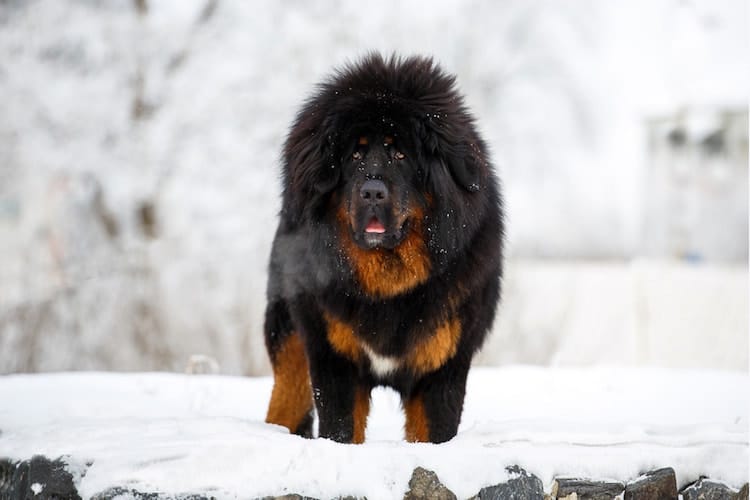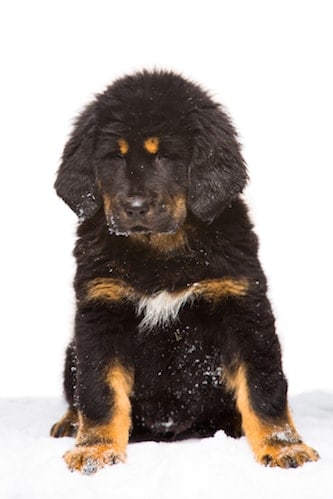The Tibetan Mastiff temperament makes him the very essence of a friendly giant. Tibetan Mastiffs are intelligent, protective and stubborn at times. And, interestingly, he’s not even really a Mastiff at all.
Other names for this breed include the Thibet dog, Thibet Mastiff, Tibetaanse Mastiff, and Tibetan dog.
Tibetan Mastiff Temperament and Personality
The three must-know traits of the Tibetan Mastiff temperament are:
- Intelligent
- Stubborn
- Protective
Here are some more aspects of this breed’s personality that you may need to know before making a final decision.
He Doesn’t Enjoy “Play”
If you’ve always dreamed of having a dog to play fetch with, or to run around with in the backyard, this dog, unfortunately, is not it.
He takes work very seriously, and he’d much rather accomplish a task for you than waste his time on fruitless play.
He’s Incredibly Strong-Willed
Perhaps one of the most important things to know about this breed is that training him early is an absolute must.
This is a breed who, as a guard dog, understands that, if no one else will, he should take the reins in a situation.
He will make the rules for himself and follow them, unless you train him otherwise. He needs to know right up front that you are the master here, not him.
He’s Devoted to His Masters
Personality wise, it’s no surprise that the Tibetan Mastiff has such devotion for his masters. It’s in his blood to protect them.
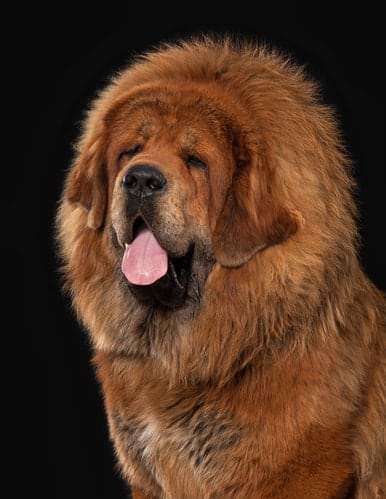
For this reason, you should never leave him outside to protect your property.
He does best when he’s with his people, not left outside all alone.
Another reason you don’t want to leave him outside is because he’ll bark while he’s out there to let you know he’s working.
This can drive the neighbors mad – and get you a citation for noise pollution – so this is yet another reason not to leave him outside.
Read our article on how to stop dog barking for more info.
He’s Very Sensitive
Tibetan dogs are also incredibly sensitive.
This is the kind of dog who gets upset if you get into an argument with your spouse and you raise your voices.
They may also step in front of you when you’re attempting to discipline your child to protect their family.
He’s a Great Guard Dog
With the Tibetan Mastiff’s large size, it's no wonder that he scares off intruders!
However, he’s so sweet that it’s only when someone appears to be encroaching on his territory that he’ll get his dander up.
You know the phrase “let sleeping dogs lie?” Well, that pretty much sums up the Tibetan Mastiff.
He’ll watch newcomers carefully, calmly, and quietly. But give him a reason to think you’re a threat, and you’ll regret the day you did that.
Take Care in How You Walk Him
Because he’s so protective, you never want to walk a Tibetan Mastiff off-leash.
Keep him close to you at all times so that if he’s wrong about a perceived threat, you can rein him in before things get out of hand.
Something else interesting about this breed is that you should vary up the routes you take when you walk him.
The reason for this is because if you take him along the same path every day, he can become protective of it.
He may therefore try to guard his route if he happens upon another dog walking with his master along the same path.
You must teach him that it’s okay to share the road.
He’s Not a Barker
That is unless you lock him outside.
The Tibetan dog has a deep, impressive bark when he wants to use it.
He won’t overuse it, though, so you don’t have to worry about him spooking the neighbors. When he barks, you know it’s for good reason.
He Loves Kids
Despite being huge, the Tibetan dog is truly a gentle giant. He has an adorable soft spot for children, particularly his own.
For those not in his own family, you will need to introduce him with care.
Interacting with Other Animals
The only time you may ever see Tibetan Mastiffs act aggressive is when they are around dogs of the same gender.
However, you can socialize this out of them, as long as you do so early (puppy stage) and often.
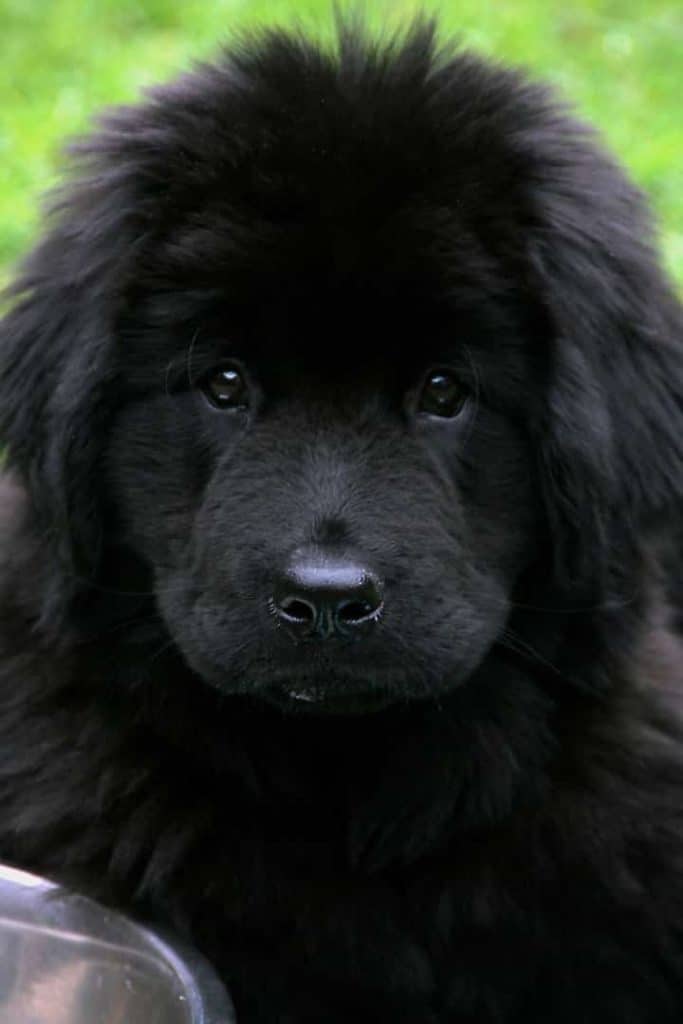
And, as long as you properly socialize him, he’s also pretty good with cats.
He’s especially calm around animals he has grown up with, no matter whether they are dogs or cats.
He’s Surprisingly Agile
You might think that a dog of this size lumbers around and knocks everything in sight over.
While that may be true inside (think of it like owning a small indoor horse as a pet), it’s a different story when he’s outside.
Make sure you have a sturdy six-foot fence around this guy. Not only can he jump anything lower, but he’s also remarkably adept at climbing.
In fact, you may want to keep an eye on him in the yard in general. Some dogs of this breed like to dig holes in the yard, which they then sleep in.
BTW if you have an problem with dog digging or just curious check out our article on how to stop dog digging.
Not an Apartment Dog
You probably already guessed this, but if you live in a smaller living space like an apartment, this breed will not do well there.
You need a lot of space for this guy to feel comfortable, and an apartment is just too small.
He Has a Schedule
The Tibetan Mastiff is usually at his most active in the mornings and in the evenings, around dinner time.
If you have the kind of schedule that keeps you out of the house during these times of day, then you will not be a good match for this breed.
He’s Not a Drooler
If you can’t stand when a dog hovers over your lap, drooling on you while he begs for food, then you’ll like the Tibetan Mastiff.
He’s not a drooler, so you don’t have to worry about cleaning up the mess that a drooling dog might make.
He Doesn’t Mind the Cold
This is a breed who doesn’t mind colder weather. So, don’t refrain from taking him for walks in the winter just because it’s cold out.
Bundle up, and he’ll be happy to go with you.
What Does a Tibetan Mastiff Look Like?
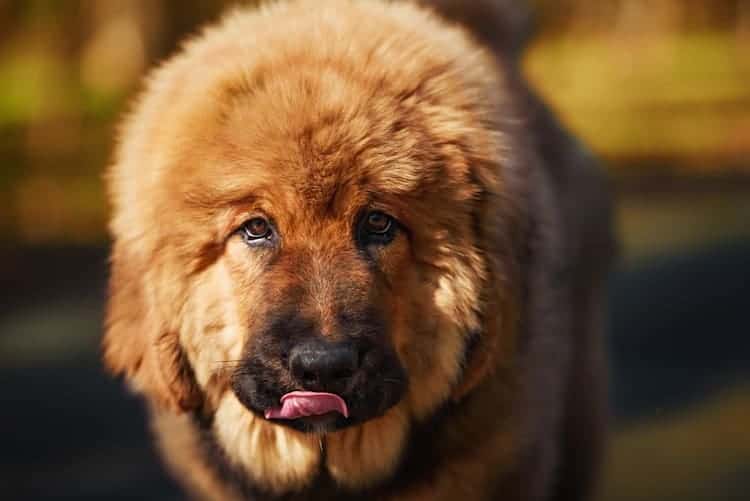
Size (Weight and Height)
If you’re wondering, how big is a Tibetan Mastiff, a healthy weight for these lovely giants fluctuates from 100 to 160 lbs. for males, and between 75 and 120 lbs. for females.
The Tibetan Mastiff height is between 26 and 30 inches for males, and between 24 and 28 inches for females.
So, the size of a full-grown Tibetan Mastiff is, to say the least, large.
Tibetan Mastiff Colors
As far as colors go, the Tibetan Mastiff comes in combinations of tan with brown or black, as well as straight black, straight brown, blue gray, or red gold.
A Brief History of the Tibetan Mastiff Dog Breed
This dog breed gets his name from early visitors to Tibet, who misnamed all large dogs as “mastiffs.”
This dog breed is not a true “Mastiff,” as Mastiffs are known today.
People used early Tibetan Mastiffs as guard dogs. They would tie the dogs up outside their homes to protect them.
Today, people still use the Tibetan Mastiff as a guard dog in Tibet to watch over the sheep.
He protects sheep from all kinds of animals – from bears and wolves to leopards, and even tigers!
How Do You Train a Tibetan Mastiff?
Training the Tibetan Mastiff can be, in a word, a nightmare.
This is because he feels he already knows all there is to know, and that there is nothing new you could teach him.
And, because he is prone to responding strongly to a threat, he will ignore you if you yell at him or resort to hitting him to correct his behavior.
It is therefore highly recommended that you bring him to obedience training while he is still a puppy.
This way, he can learn everything he needs to know while he’s still young, and before he becomes set in his ways.
Helpful Dog Training Resource:
For help with training your dog, you should take a look at The Online Dog Trainer by Doggy Dan. Doggy Dan is an expert Dog Trainer based in New Zealand. His online resource contains Hundreds of Excellent Dog Training Videos that will take you step-by-step through the process of developing a healthy, happy well-behaved dog.
How Do You Groom a Tibetan Mastiff?
Despite having such a heavy coat, the Tibetan Mastiff actually doesn’t require much grooming.
A brushing two to three times per week, along with a run-through with a detangler comb, is sufficient.
Tibetan Mastiffs will also “blow” or shed their entire coats once a year – usually during late spring or in the summer.
When this “blow” occurs, you can help it along by brushing the dog with a de-shedding tool.
Is the Tibetan Mastiff Hypoallergenic?
If you’re wondering “is the Tibetan Mastiff hypoallergenic”, the answer, unfortunately, is no.
This means if you tend to have allergic reactions around dogs, then this floofy giant is not a good match for you.
Exercise
As you might expect, the Tibetan Mastiff will go insane with unused energy if he’s trapped in the house all day.
You don’t need to take him for a mile run twice a day, but an average level of exercise will suffice.
As you should expect, he won’t do well in smaller living spaces, like apartments. they also hate the heat.
It’s also important that you don’t over-exercise your Tibetan Mastiff while he’s still a puppy. He actually needs that excess weight to help his bones grow stronger.
Food
You may think that a Tibetan Mastiff, being a larger dog, must need to eat a ton just to keep up with his daily calories. This is not true.
Two to four cups a day of high-quality food is all he needs to satisfy his hunger.
Tibetan dogs are very good at only eating when they’re hungry. In fact, they have been known to skip an entire meal from time to time.
Here’s something interesting: when a female Tibetan dog is in heat, the males may refuse to eat for up to a week. This can cause their weight to drop by as much as 10 to 15 percent.
Staying Healthy: Tibetan Mastiff Health Issues
The lifespan of a healthy Tibetan dog is between 10 and 14 years. However, there are a host of health concerns that can affect this breed. Such conditions can include:
- Panosteitis– inflammation of the bones
- Osteochondrosis dissecans– abnormal cartilage growth
- Hipor elbow dysplasia
- Canine Inherited Demyelinative Neuropathy (CIDN) – a condition that affects the nervous system
- Autoimmune hypothyroidism
Most of these conditions are hereditary, so it is important that you have your dog screened before you buy or adopt him.
Panosteitis will go away as the dog gets older, and hypothyroidism is a condition that presents in older dogs.
A dog suffering from Osteochondrosis Dissecans may require surgery, and it can show up in Tibetan Mastiff puppies as young as five months old.
Finding the Perfect Tibetan Mastiff Puppy
If you're in the market for a Tibetan Mastiff puppy, you may want to consider adoption over purchasing a puppy.
This breed is not in high supply. They are, in fact, quite rare, which can make the price of a Tibetan Mastiff incredibly high.
Tibetan Mastiff Puppies for Sale
The Tibetan Mastiff price tag may surprise you. Because these dogs are so rare, especially purebreds, you're looking at spending between $2,500 and $3,000 for a puppy.
However, prices vary, depending on the part of the country you're in and the breeder you select.
Speaking of rare, back in 2011 there was a Red Tibetan Mastiff – “Big Splash” – who became the world's most expensive dog when he sold for $1.5 million!
Tibetan Mastiff Rescue and Adoption
When it comes to Tibetan Mastiff rescues, this Delaware company (Tibetan Mastiff Rescue, Inc.) is the expert.
Formed in 2003, the organization is the only one of its kind in the U.S. dedicated to rescuing this specific breed.
Because the breed is so rare, you may need to go through a specialty service like this one in order to adopt a dog.
If you're considering adopting a Tibetan dog, you may want to adopt an older dog, rather than a puppy. There are two reasons for this:
- He will already be housebroken or potty trained.
- An older dog will be past his destructive puppy phase.
Tibetan Mastiff Breeders
When you're dealing with a breeder, you always want to make sure you use someone reputable. This is especially true when dealing with Tibetan Mastiff breeders, considering the cost of the dog.
The American Tibetan Mastiff Association (ATMA), a member of the American Kennel Club, can help you find the perfect breeder.
However, despite their breeder referral program, the ATMA advises anyone who decides to purchase a puppy from a breeder to put in writing any and all promises or guarantees made by the breeder.
The breeder should also provide you with a purchase contract, which also provides a promise that he or she will fulfill all of his or her responsibilities for the life of the dog.
Tibetan Mastiff Mixed Breeds
If a Tibetan Mastiff mix is what you seek, then you’re in luck – there are a few out there.

For instance, you might be interested in:
- A Tibetan Golden Mastiff, which is a Golden Retriever mix.
- Or maybe the Tibetan Wolfhound is more your flavor, which is an Irish Wolfhound mix.
- We list 15 Tibetan Mastiff Mix-breeds in our article here.
Caucasian Shepherd vs Tibetan Mastiff
If you’re torn between choosing a Caucasian Shepherd and a Tibetan Mastiff as your next pet, the best thing you can do is compare the temperaments of these two breeds.
This will help you decide which dog is the better choice for you and your family.
The good news is, with these two breeds, they are so similar that it essentially boils down to which dog you find prettier.
Both of these large dogs are incredibly intelligent and loyal, and they both calm down once they’ve grown out of puppyhood.
They both require a heavy amount of grooming, and they’re both pretty healthy breeds.
A Final Word about the Tibetan Mastiff
Despite the enormous size of this breed, the Tibetan Mastiff temperament makes this gentle giant a love – unless, of course, you try to intrude upon his home or threaten his family.
He's also a rare breed, so if you're interested in buying one, they can be pretty expensive.
And because he's so rare, it may be more difficult to find one available to adopt. A specialty service like Tibetan Mastiff Rescue Inc. can help.
There are several health problems that plague the breed, but if he's in good health, you can expect him to live between 10 and 14 years.

Kailyn has worked as a professional freelance writer since 2012, and during that time she has written about nearly every dog breed imaginable. Her mother loved Collies, and so Kailyn grew up with three of them throughout her childhood – including a blonde one who was half-blind! Now her home belongs to her first official dog, Macho, a Dogo Argentino rescue.
